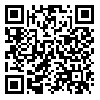Tue, Dec 2, 2025
[Archive]
Volume 13, Issue 39 (2021)
JMED 2021, 13(39): 56-63 |
Back to browse issues page
Download citation:
BibTeX | RIS | EndNote | Medlars | ProCite | Reference Manager | RefWorks
Send citation to:



BibTeX | RIS | EndNote | Medlars | ProCite | Reference Manager | RefWorks
Send citation to:
Imanipour M, Razaghi Z, Khajeh K. Orientation to receive feedback among medical and nursing students of Shahid Beheshti University of Medical Sciences, 2019. JMED 2021; 13 (39) :56-63
URL: http://edujournal.zums.ac.ir/article-1-1302-en.html
URL: http://edujournal.zums.ac.ir/article-1-1302-en.html
1- Nursing and Midwifery Care Research Center, Tehran University of Medical Sciences, Tehran, Iran
2- Biostatistics Department, Shahid Beheshti University of Medical Sciences, Tehran, Iran
3- School of Management and Medical Education, Shahid Beheshti University of Medical Sciences, Tehran, Iran. ,khaje4915@gmail.com
2- Biostatistics Department, Shahid Beheshti University of Medical Sciences, Tehran, Iran
3- School of Management and Medical Education, Shahid Beheshti University of Medical Sciences, Tehran, Iran. ,
Abstract: (12161 Views)
Background: Providing and receiving feedback during clinical training is one of the indicators of effective teaching and better learning. Different factors are related with efficacy of feedback that may refer to teachers or students. This study aimed at orientation of medical and nursing students to receive feedback in their clinical training course.
Methods: This is a descriptive study that was done on 495 students (278 medicine and 217 nursing students) who were selected by quota and convenience sampling. The data collection tool was feedback orientation scale that was completed by students in a self-administered method. Validity and reliability of the questionnaire were determined by content validity and internal consistency (α = 0.90), respectively. The results were analyzed by SPSS software (Ver. 16) using T-Test, ANOVA statistical tests.
Results: In this study, orientation to receive feedback was more than mean score and was significantly higher in nursing students in comparison with medical students (P=0.031, t=-2.94). As well, the students as starters tended more to receive feedback than interns (P=0.01, t=-2.46). There was a significant relationship between the orientation to receive feedback with students’ age, grade point and interest in the major (P <0.05).
Conclusion: With considering of difference in students’ orientation to receive feedback, it is suggested that pay attention on this point in educational planning and try to improve attitude of some students who have a poor orientation to feedback through taking appropriate measures. As a result, the status of more acceptance of feedback will provide to them.
Methods: This is a descriptive study that was done on 495 students (278 medicine and 217 nursing students) who were selected by quota and convenience sampling. The data collection tool was feedback orientation scale that was completed by students in a self-administered method. Validity and reliability of the questionnaire were determined by content validity and internal consistency (α = 0.90), respectively. The results were analyzed by SPSS software (Ver. 16) using T-Test, ANOVA statistical tests.
Results: In this study, orientation to receive feedback was more than mean score and was significantly higher in nursing students in comparison with medical students (P=0.031, t=-2.94). As well, the students as starters tended more to receive feedback than interns (P=0.01, t=-2.46). There was a significant relationship between the orientation to receive feedback with students’ age, grade point and interest in the major (P <0.05).
Conclusion: With considering of difference in students’ orientation to receive feedback, it is suggested that pay attention on this point in educational planning and try to improve attitude of some students who have a poor orientation to feedback through taking appropriate measures. As a result, the status of more acceptance of feedback will provide to them.
Article Type : Orginal Research |
Received: 2020/04/9 | Accepted: 2020/12/1 | Published: 2021/01/3
Received: 2020/04/9 | Accepted: 2020/12/1 | Published: 2021/01/3
Send email to the article author
| Rights and permissions | |
 |
This work is licensed under a Creative Commons Attribution-NonCommercial 4.0 International License. |





